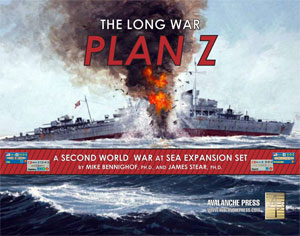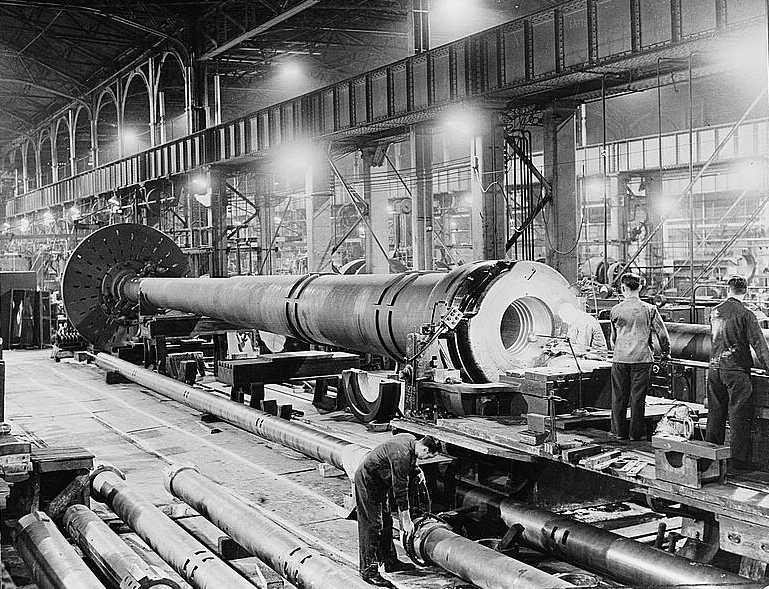| Plan Z:
Britain’s Lion Class
By Mike Bennighof, Ph.D.
May 2021
 Having settled for a less-capable battleship with the King George V class, the Royal Navy determined that its next class would match the size, firepower and speed of the new ships being built in other nations. Having settled for a less-capable battleship with the King George V class, the Royal Navy determined that its next class would match the size, firepower and speed of the new ships being built in other nations.
King George V’s design met the specifications of the 1936 Second London Treaty as originally intended, with a maximum caliber of 14 inches for main armament. Japan’s refusal to accept the lower caliber voided that clause, but design work for King George V was already well advanced and when the architects ruled that they could not easily modify the ship to take a 16-inch main battery the Admiralty chose not to scrap the plans. The new ships were built with a lighter main armament than other nations’ new battleships.
 The Lion class was designed under the “escalator clause” of the Second London Treaty, which allowed battleships of up to 45,000 tons’ displacement (the original limit had been set at 35,000 tons, but Japan’s refusal to sign raised the maximum displacement for all signatories). Even so, the design did not take full advantage of the allowable displacement; out of cost considerations and to fit in existing docks (plus pass through the Panama Canal) the new battleship would be limited to 40,000 tons. The Lion class was designed under the “escalator clause” of the Second London Treaty, which allowed battleships of up to 45,000 tons’ displacement (the original limit had been set at 35,000 tons, but Japan’s refusal to sign raised the maximum displacement for all signatories). Even so, the design did not take full advantage of the allowable displacement; out of cost considerations and to fit in existing docks (plus pass through the Panama Canal) the new battleship would be limited to 40,000 tons.
While the Germans were busily designing a disastrously bad battleship with their much larger H class, the British architects drafted a very fine ship. Lion would have strongly resembled King George V, with a very similar (and heavily armored) superstructure, an athwartships catapult and a similar armor scheme (though that part wouldn’t have been visible).

Boring out a barrel for a 16-inch Mark II rifle.
The big difference came in armament: nine 16-inch Mark II 45-caliber rifles in three triple turrets, two forward and one aft. This would be a new weapon, discarding the dissatisfactory design of the 16-inch Mark I that armed Nelson and Rodney for a scaled-up version of King George V’s outstanding 14-inch Mark VII (the turrets of King George V were poorly-designed, but the guns themselves were excellent). Like that of its model, the new gun’s design emphasized accuracy over range, but it remained a powerful weapon. It did not have quite the striking power of the American 16-inch 45-caliber rifles that armed the North Carolina and South Dakota classes, but had comparable performance to the German 16-inch gun of the H class. They were a definite step forward from the 16-inch Mark I, firing a heavier shell and showing much greater accuracy and durability.
 Secondary armament would have been identical to King George V: sixteen 5.25-inch dual purpose guns in eight twin mounts. Not only the same number, but exactly the same layout. They would be supplemented by 42 Bofors 40mm anti-aircraft guns, the same number initially fitted in King George V; later in the war the surviving ships of the class received many more. The design team cheated on the weight limit a little by listing Lion’s ammunition load as a ridiculously-low 60 rounds per main gun, but constructing her magazines to actually hold about twice that many (a difference of about 500 tons). Secondary armament would have been identical to King George V: sixteen 5.25-inch dual purpose guns in eight twin mounts. Not only the same number, but exactly the same layout. They would be supplemented by 42 Bofors 40mm anti-aircraft guns, the same number initially fitted in King George V; later in the war the surviving ships of the class received many more. The design team cheated on the weight limit a little by listing Lion’s ammunition load as a ridiculously-low 60 rounds per main gun, but constructing her magazines to actually hold about twice that many (a difference of about 500 tons).
Lion would have been slightly larger than King George V, to accommodate not only the heavier main armament but a larger power plant as well. She would have made 130,000 horsepower, compared to 110,000 for King George V, and would have had a transom (flattened) stern, a first for British capital ships (Vanguard, designed after Lion, shared this feature as well). Hydrodynamic testing in a ship model basin showed that the new hull form would increase speed by about three percent. With the new-model stern and more horsepower, Lion was expected to make 30 knots compared to 27 for King George V. The architects made up some of the weight by making Lion relatively short-legged; she carried less fuel than any other oil-fired British capital ship.
 Protection would be very similar to King George V, with the belt armor extending deeper under the waterline than in the previous class and a heavily-armored conning tower compared to the light armor of King George V. King George V lost her four seaplanes in 1943; that probably would have been the case with Lion as well. Protection would be very similar to King George V, with the belt armor extending deeper under the waterline than in the previous class and a heavily-armored conning tower compared to the light armor of King George V. King George V lost her four seaplanes in 1943; that probably would have been the case with Lion as well.
Design work began in 1937, with the final characteristics decided in the spring of 1938 and the Admiralty stamp of approval affixed in December of that year. Two ships were ordered in February 1939, with Lion laid down at Armstrong’s Newcastle yard in July and Temeraire at Cammell-Laird in Birkenhead in June. A further two ships were ordered in August, Thunderer (originally named Bellerophon) from John Brown in Clydebank and Conqueror at Fairfield’s Glasgow yard.
Only a few hundred tons of steel had been erected when construction of the first two ships halted in October 1939; no work had been done on the second pair. Officially this was only a temporary suspension, and the orders were not cancelled until 1944.
 Proposals to re-start construction surfaced throughout the rest of the war and afterwards; each new draft increased the size of the ship, her endurance, protection and anti-aircraft armament. These were fantasy proposals like those made by naval architects in all the warring powers (constant work kept the young architects out of the draft pool): the war had nearly impoverished Britain and even building Vanguard (a supposedly “cheap” project) proved a great economic strain. Lion and Temeraire surfaced again in the 1945 building program, to be laid down the next year and completed in 1952, but this was never financially possible even if the battleship still had a future. Even so, the Admiralty did not formally give up on Lion until 1949 when First Sea Lord Bruce Fraser ordered an end to battleship designs. Proposals to re-start construction surfaced throughout the rest of the war and afterwards; each new draft increased the size of the ship, her endurance, protection and anti-aircraft armament. These were fantasy proposals like those made by naval architects in all the warring powers (constant work kept the young architects out of the draft pool): the war had nearly impoverished Britain and even building Vanguard (a supposedly “cheap” project) proved a great economic strain. Lion and Temeraire surfaced again in the 1945 building program, to be laid down the next year and completed in 1952, but this was never financially possible even if the battleship still had a future. Even so, the Admiralty did not formally give up on Lion until 1949 when First Sea Lord Bruce Fraser ordered an end to battleship designs.
The King George V class took about four years to build from laying down to commissioning; the Lions likely would have taken about the same time and been available some time in 1943, when our Second World War at Sea: Plan Z takes place. The would have been significantly better fighting ships than the German H class, and roughly equivalent to the American South Dakotas (less formidable main armament, but better speed).
All four planned ships are included in Plan Z; they appeared in our out-of-print East of Suez some years ago but we’ve given them a brand-new (and far nicer) drawing. Their short range precludes some convoy escort missions, but they are formidable in the waters around the United Kingdom.
Click here to order Second World War at Sea: Plan Z (book edition) right now.
Please allow an extra two weeks for delivery.
Sign up for our newsletter right here. Your info will never be sold or transferred; we'll just use it to update you on new games and new offers.
Mike Bennighof is president of Avalanche Press and holds a doctorate in history from Emory University. A Fulbright Scholar and NASA Journalist in Space finalist, he has a whole passel of books, games and articles on historical subjects.
He lives in Birmingham, Alabama with his wife, three children and his dog, Leopold. Leopold is well-designed.
|
